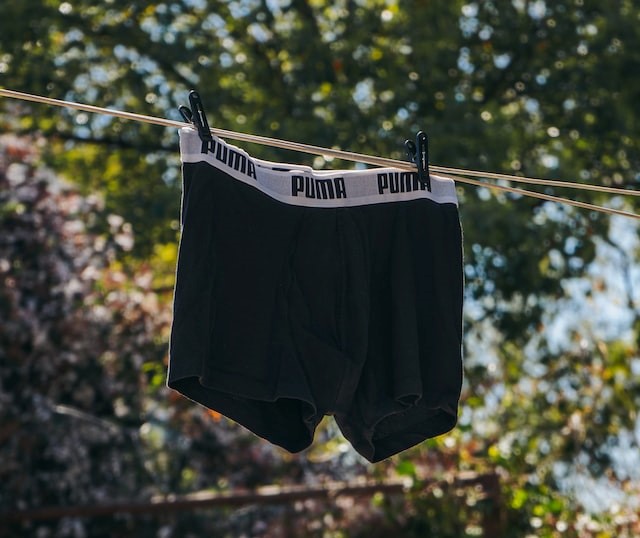Clothing, by and large, provides a form of extra protection for the body. Outerwear can give us extra warmth, or prevent clothes underneath from being soaked through in wet weather. Underwear can also provide an extra layer, helping to trap warm air between layers. It also stops your other clothes from rubbing or irritating the body.
Underwear has changed a lot over the centuries, especially for women. Outerwear as a concept is more recognisable. Styles and fashions change, but the general principle behind outerwear largely doesn’t.
Unsurprisingly, both are also subject to a range of superstitions themselves. We’re covering these last two parts of the clothing puzzle now in terms of folklore! Keep reading or hit ‘play’ to hear the audio version of this article.
Coats
We talked about the practice of turning your clothing inside out if you thought you’d been fairy-led (or Piskie-led in Cornwall). The coat was one of the easiest things with which to do this. It depends on the nature of the coat, clearly. I’d struggle to wear my leather jacket inside out, for example. Though I think the overcoats of yesteryear might have been easier to wear inside out due to their construction.

Fastening an inside-out coat would be difficult, and fastenings of coats even play into the superstitions. People considered it bad luck to button a coat wrong. Putting old buttons on a new coat brought bad luck, although a coat with eight buttons was considered lucky (Daniels 2003 [1903]: 420).
They also suggested putting money in the righthand pocket of your new coat to bring good luck and more money. This ‘like attracts like’ principle appears in folklore as a form of sympathetic magic (Destefano 1969: 49).
Be careful you don’t put the money in the lefthand pocket though; if you do, you’ll always want for money as long as you wear the coat (Daniels 2003 [1903]: 430). The superstitions don’t specify if you can simply transfer the money from left to right, or if putting it in the wrong pocket ‘dooms’ the coat.
Be careful your coat doesn’t get caught up in your seat at the theatre. If it does, you’ll be sorry you went (Daniels 2003 [1903]: 429). That seems like a rather melodramatic reaction to what is probably a minor inconvenience.
It was believed to indicate love if a woman picked a thread off a man’s coat (Daniels 2003 [1903]: 82).
A Pennsylvanian superstition claimed a girl would become infatuated with you if you sewed a locket of her hair into your coat (Daniels 2003 [1903]: 72). Or, you could just focus on being a decent guy instead of coercing someone into loving you. shrugs
Coats and the Butterfly Charm
Coats played a role in a strange butterfly charm from Sheffield. Recorded in 1902, the boys would go looking for butterflies, singing a song with lyrics that read:
“Butterfly, butterfly, fly away home,
(Addy 1903: 432)
Your house is on fire and the children all gone,
All but one set under a tree,
Writing a letter as fast as she can”.
Once the boys found a butterfly, they stopped singing, took off their coats, and, holding their coats by one sleeve, tried to throw the coat over the butterfly.

The article about it in the Folklore journal suggested that the practice may have had an unusual origin. You might recognise the words as being similar to those spoken of ladybirds.
Given the belief the butterfly represents the soul, S. O. Addy suggested that the charm originally intended to capture a wandering soul to return it to its home, where it needed to deal with a calamity (1903: 432). The use of the coat as a makeshift net allows the charm to be used in a fairly sporadic way, though the article didn’t say what the boys did with any butterflies they caught. Indeed, throwing a coat over one would likely damage its wings.
Undergarments
The concept of undergarments has certainly changed over time.
In the Middle Ages, women wore a chemise under their dresses. By the 16th century, corsets appeared, altering a woman’s silhouette until the early 20th century. The crinoline petticoat arrived in the 1830s to create the distinctive bell-shaped skirt, while pantaloons emerged in the 1870s to cover women’s calves and ankles under their dresses.
Lingerie only appeared in the 1920s, favoured by the flappers, while girdles were popular in the 1930s as a form of shapewear. They gave the desired shape without being as restrictive as a corset (Deczynski 2014).

And that’s just women’s underwear!
The men’s shirt, that staple of contemporary formalwear, was originally an undergarment, often hidden by waistcoats or cravats (Cole n.d.). That’s why “that scene” in the 1995 Pride and Prejudice in which Lizzie encounters Darcy in a wet shirt after his impromptu swim in the lake was so saucy. She’d essentially seen him in his underwear!
The T-shirt was also originally a part of men’s underwear, often worn by labourers to help keep them warm and absorb sweat. By the 1950s, they were adopted as regular clothing by teenagers, and the rest is history (Cole n.d.).
And yes, even in the 18th century, men wore shapewear too.
Underwear Superstitions
Despite these changes, some superstitions I collected from the turn of the 20th century still seem to refer to undergarments we would recognise.
Losing your underwear apparently meant your partner loved someone else (Daniels 2003 [1903]: 507).
It was considered bad luck to cut out the pieces for undergarments on a Friday; if they were, they’d be used to dress a corpse (Daniels 2003 [1903]: 507).
People would turn their undergarments inside out to try to ‘turn their luck’ during a streak of bad luck (Daniels 2003 [1903]: 507).

This one is quite specific, but if you wore two undershirts, you had to ensure the top one was longer than the one beneath. Otherwise, it meant you loved your father more than your mother (Daniels 2003 [1903]: 507). This one reminds me of a similar superstition about petticoats; if your petticoat was longer than your skirt, it meant you loved your father more than your mother.
It’s suggested this came from the fact that an observant mother would notice the difference in length, while a father wouldn’t. Therefore, continually wearing the wrong length would suggest you didn’t have someone to point it out.
The Cutty Sark
Speaking of women’s underwear, it seems only right to mention the Cutty Sark! Many people know the name as that of the famous clipper ship, now available to visit in Greenwich.

The name originally comes from Robert Burns’ 1791 poem, ‘Tam o’Shanter’. In it, Tam stumbles across a coven of witches dancing. One witch, Nannie Dee, is dancing in her sark, the Scottish version of a short chemise. Nannie got the sark as a child, so she’d outgrown it and it was now too short, which explains the ‘cutty’ part of the name.
Tam yells ‘Weel done, Cutty-sark” at the sight of her dancing. Nannie Dee in her sark went on to become the ship’s figurehead when it was ordered in the 1860s. She even still grips the pony’s tail in one hand, the only thing she manages to grab during her chase of Tam.
Corsets and Girdles
These are perhaps some of the most uncomfortable parts of women’s underwear. They’re designed to produce a specific silhouette, although fashion historian Bernadette Banner busts quite a few of the myths that corsets were a tool of the patriarchy. Don’t argue with me, go watch the video, and learn from someone with experience.
But given the fact that corsets and girdles were part of everyday clothing, it’s hardly surprising there would be folklore attached to them.

If your girdle broke, it meant you’d receive a visit from a welcome guest (Daniels 2003 [1903]: 508). I’m assuming that’s from Murphy’s Law, that you’d see the one person you wanted to see, right when you didn’t feel sufficiently dressed to receive them.
Dreaming of a girdle meant you’d have a successful marriage. If it was broken, the dream urged caution for danger was present. An old and worn girdle in a dream meant trouble was coming. A golden girdle meant wealth, a silver one meant loss, and a copper one meant happiness (Daniels 2003 [1903]: 230).
You could also see an image of your true lover using this corset-based divination. Upon going to bed, remove your corset, roll it up, and repeat this charm three times;
I roll it, oh roll it, ah roll it up tight,
(Daniels 2003 [1903]: 80)
And hope that my true love I’ll see in the night.
Not in his coffin and not in his clay
But in the good clothes that he wears every day.
Lucky Underwear
We mentioned lucky clothing in the Clothes article, but it bears repeating here since underwear is an easy thing to wear to bring luck. A popular reason is to help your sports team win a particular game.
And look at Bridget Jones in the 2001 movie, trying to choose underwear based on the desired outcome of a date. There’s almost an element of luck involved here too; according to Murphy’s Law, you might feel more likely to bring home your date if you were wearing hideously ugly underwear!

I asked about lucky underwear on Twitter, and received a range of responses! One person said they didn’t wear lucky undies, but that several people on their high school football team wore no underwear at all for luck. It didn’t work.
Rob Saunders noted that baseball players are supposed to be the most superstitious of sportspeople, and some don’t change their underwear while they’re on a winning streak. This chimes with the folklore that if you put on clothes inside out, you shouldn’t turn them the right way or you’d ‘turn the luck’. Not changing your underwear would potentially have the same effect. It’s also gross.
Another follower said their brother wore lucky boxers to help Everton, while their partner wore red socks or a red T-shirt when Crewe play. I asked if they worked, and she said her brother stopped wearing the lucky boxers after he forgot one time and the team still won.
And another reply was perhaps my favourite. A follower knew someone whose lucky underpants were any pants she had been wearing when she wasn’t run over.
Two people said they always wore red knickers on New Year’s Eve to bring good luck and/or money.
Another respondent told me that she’d kept her wedding underwear, since it was the only time she’d worn non-black underwear. She wasn’t planning on getting married again, but out of superstition she’d hung onto it!
Finally, someone recommended wearing brown socks while fighting legal battles to get justice.
What do we make of lucky coats and knickers?
I think it’s the same as everything else that we’ve looked at as part of the folklore of clothing. You’ve got these items that are easy to associate with luck based upon what was happening while you were wearing them.
Yet where underwear is concerned, the lore is a little more about specific, examining what happens if it breaks, or if you cut these pieces out on a given day. It’s a little bit less about the items specifically, and more about the person’s interaction with them. We’ve talked before about how personal shoes and gloves are since they mould themselves to the wearer, but with underwear, it’s the closest thing to your skin. Yet weirdly, it doesn’t seem to have a lot of the same associations that gloves and shoes.
But ultimately, whether you want to wear lucky underwear, whether you want to put sort of a couple of coins in the right hand pocket of a new coat is entirely up to you. There’s no real evidence superstition works but to be honest with you? There’s also not really necessarily evidence to say that it doesn’t on a personal level. If following a superstition that doesn’t harm anyone else makes you generally feel better then does it matter what other people think?
Do you have any personal traditions involving outerwear or underwear?
References
Addy, S. O. (1902), ‘Butterfly Charm’, Folklore, 13 (4), pp. 432–432.
Cole, Shaun (no date), ‘A brief history of men’s underwear’, V&A, https://www.vam.ac.uk/articles/a-brief-history-of-mens-underwear.
Daniels, Cora Linn and C. M. Stevans (eds) (2003 [1903]), Encyclopaedia of Superstitions, Folklore, and the Occult Sciences of the World, Volume 1, Honolulu: University Press of the Pacific.
Deczynski, Rebecca (2014), ‘A Brief Evolution of Underwear’, Good Housekeeping, https://www.goodhousekeeping.com/beauty/fashion/tips/a24247/evolution-of-underwear/.
Destefano, Carl, & Hand, Celeste (1969), ‘Folk Beliefs about Clothing’, Western Folklore, 28 (1), pp. 49–49.
Nutty about folklore and want more?
Add your email below and get these posts in your inbox every week.
You'll also get my 5-step guide to protecting your home using folklore!








Have your say!